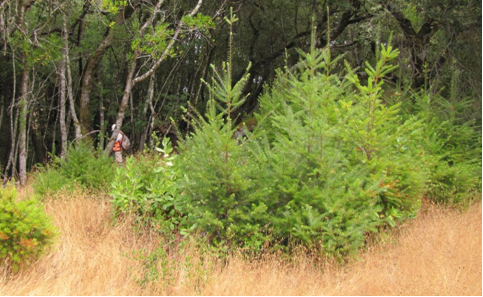
Most sites support natural regeneration of various herbaceous and woody species. Natural regeneration may be so plentiful that resulting stands will need to be thinned. If natural regeneration of preferred species is sparce and weak you may need to favor it through cultural inputs. These may include protection from browsing animals or reducing competition from weedy species and fast-growing native plants (fig. 3-7).
Potential regeneration may be present as dormant seeds . When canopy gaps form due to SOD-related mortality, changes in the light or temperature environment at the site may increase germination of dormant seed. Fire or soil disturbance (e.g., tillage) may also promote germination. Seed may be transported to the site by wind, water, or animals. Germination of this incoming seedfall may also be favored by soil disturbance and canopy gaps.
Existing seedlings and saplings are another source of natural regeneration. Oaks and many other forest trees have short- lived seeds. These seeds germinate within a year, and seedlings develop to a limited degree. Seedlings remain small because overstory trees limit their access to light and soil moisture. These persistent seedlings (also known as advance regeneration or a seedling bank) may grow rapidly when overstory trees die or are removed.
Stump sprouts are another potential source of natural regeneration. Resprouting from stumps is common among many species found in SOD-affected forests, including most oaks, tanoaks, bay, and coast redwood. SOD-killed oaks and tanoaks may produce basal sprouts that can give rise to a new tree. A disadvantage of this sprout regeneration is that trees that develop are guaranteed to be SOD-susceptible, since they are a clone of the susceptible parent. If a source of P. ramorum spores is still present in the area, the resulting trees are likely to develop SOD cankers eventually. In addition, sprout-origin oaks may have poor structural properties. Decay associated with the old stump may increase failure potential and reduce the useful life of these trees. However, stump sprouts can show fast growth due to their established root systems and may be useful to quickly provide replacement tree canopy, at least over the short term.


Figure 3-7—Madrone and Douglas-fir regeneration in a SOD-related canopy gap shown in September 2008 (top) and October 2010 (bottom). The gap formed due to mortality of a large coast live oak that died in 2002 and failed two years later. Without management, the faster growing Douglas fir regeneration is likely to outcompete the madrone.